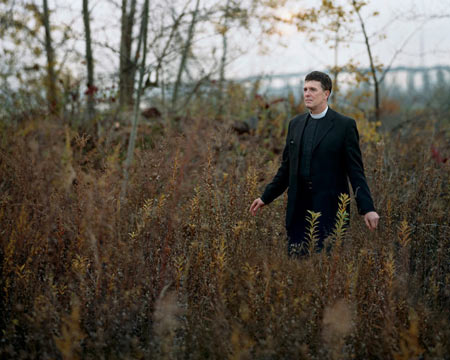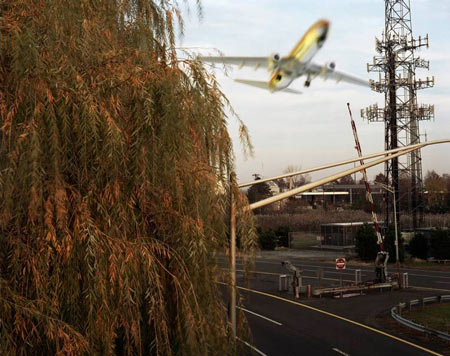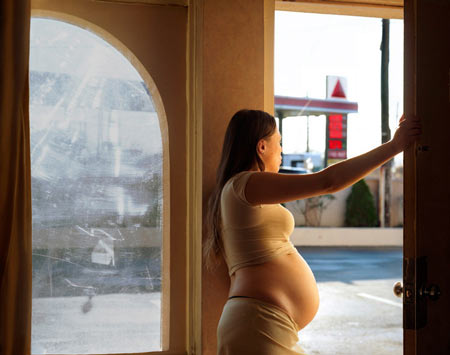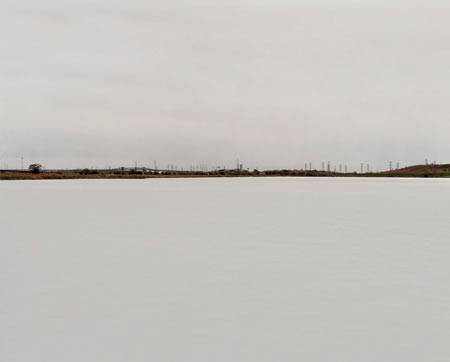A Conversation with Joshua Lutz

Joshua Lutz just had Meadowlands published, after spending ten years on the project. His book (and recent show) had me curious about the background of the project, and I approached Joshua to talk about it.

Jörg Colberg: You spent ten years on your project Meadowlands, which was recently published as a book and subject of a very successful exhibition at Clamp Art, a body of work centered on what many people would probably think of as maybe one of the most unappealing pieces of land in the United States: A large piece of land, a lot of it swamp, that separates New Jersey from New York City. It’s also the first bit of the US that I ever got to see after my plane had landed at Newark Airport ten years ago. I remember thinking how ugly the area was, while the view of the New York City skyline just beyond that wasteland was one of the biggest thrills I had ever experienced. Why the Meadowlands?
Joshua Lutz: It is interesting to think about that relationship between New York City and The Meadowlands. How one piece of land becomes so built up while the other remains something of an industrial wasteland made up of swamps and landfill. I just finished this biography of Henry Hudson where they talk about that decision to create a settlement in what is now Manhattan and north of Manhattan rather than just south in New Jersey because that area of the river was just too iced over. Living in Manhattan, the Meadowlands was really about finding these little places hidden within areas where I would not expect them to be. In the Meadowlands I can park my car at the outlet center and pop the canoe into the swamps and just start exploring. If I don’t want to drive, it’s a six-minute train ride. There is something extremely accessible about that. That really enabled me to explore it in ways and for a period of time that would have otherwise been too difficult. Instead of going on two or three week trips this was a place that I could return to weekly.

JC: Given that the Meadowlands were initially a way to escape the City, at what stage did you realize you actually had a real photography project? And when you arrived at that point did that change how you approached photography there?
JL: When I started photographing the Meadowlands I was really determined to somehow document this place. Somewhere along the way I began to rethink my relationship to the Meadowlands as well as some of limitations of the document and of photography in general. That switch really changed my approach to what I thought the final product could be. It was liberating to think that I could use this place as way of expressing myself and not be constricted with the burden of the document and representation. Once I felt that I had enough strong images that were working together and not repeating themselves I started to think that this just might have legs beyond a box of prints.
Generally I shoot for a few months without spending too much time looking at what I’ve got. I’ll then take the next few months looking at the pictures, thinking about them, moving them around and trying to figure out what it was I was doing out there. Each time I take that break where I am thinking about the images and not shooting it changes my approach. I think these breaks have a much larger effect on how I approached photographing there than realizing any potential that the work might have.

JC: There’s such a wide variety of imagery in Meadowlands - how did you decide what to show, what to look at?
JL: What to show was a lot easier than what to look at. When I first started photographing the Meadowlands I spent a few years just exploring and taking pictures of what interested me; be it the light on the water or the skyline of the city. I wanted to figure this place out. It is an astonishing mixture of towns, swamps, trains, motels and an amazing array of bisecting highways all trying to keep you out. I have this tendency to think like that, make lists and work in typologies even though I never want the work to be seen that way. About halfway through the project I began making lists of different types of images that I wanted and then I would try to create them. For example thinking about the Meadowlands as a transient location I started to look for motels and single residence occupancies. All I saw for a year were these motels. There could have been a tornado right in front of me and I would be thinking where the nearest motel was. I then started to wonder about the airport and its impact on the Meadowlands, which got me thinking about creating images about planes. The end is this group of somewhat disparate images all related to this idea of the Meadowlands.
In terms of what to show it wasn’t as if I had thousands of great images laid out on the floor to choose from. Each year that went by there were only a handful of images that I was happy with. When the time came to do a final edit I pretty much knew what I wanted. This is a very limiting model and prevents the possibility of different types of images to be created. Maybe this is why it took ten years.

JC: On your website you talk of the Meadowlands as a place that has to do with solitude and loneliness, and in many of the images the persons portrayed do indeed look a bit lost. Are loneliness and solitude things that you crave, given the craziness of New York City, or is there more to it?
JL: It is more about fear of those emotions more than it is about craving them. I don’t crave loneliness by I do seek solitude. Even though I like spending a lot of time alone I hate feeling lonely, it’s a horrible feeling. The city is neither here nor there when it comes to loneliness. It is really what you make of it, the support group you surround yourself with. The city does make me want to escape the intensity of the crowds, sounds and images. There have been countless days when I would run down to B&H to pick up film, get frustrated with the lines and just head into the Lincoln tunnel and drive straight to the Meadowlands to escape.
JC: Do you think that with the photos in The Meadowlands you also took a portrait of what solitude can mean? When I first saw the images I thought there was a bit of a slightly melancholic air to them - something that made the photography more interesting for me.
JL: In many ways I think that it can be a portrait of what solitude can mean although I never wanted it to be too melancholy. I really don’t associate the two together. I do think it is the photographs of the grey skies that have that effect more than the portraits. For a while I thought that there were too many grey sky images and I made an effort to shoot on clear days with blue skies. It is amazing how those few pictures with a blue sky in the book make the grey ones look really grey. I think we come to images with all these associations of what grey skies mean. Somehow blue skies are happy and grey skies are sad. Think about all those songs that talk about blue skies. My favorite’s the Willie Nelson one.

JC: After ten years, the project was done. What made you decide it was done? Or maybe it would be more natural to ask why did it take a total of ten years - that’s a long period of time?
JL: Frederick Sommer talked about how if he took one good image a year it was a successful year. It would be great to leave it at that, but really it is more about how my relationship to the Meadowlands grew. As I mentioned I became less interested in the Meadowlands as a documentary project and more interested in what we were discussing earlier - be it how this place can serve as a metaphor for issues such as loneliness and solitude or anything else for that matter. It’s one of the reasons why I don’t caption or title the images. I like the idea that people can bring whatever baggage they come with to these images and not be bogged down by the actual specifics. That totally does not answer your question, let me try again. How did I know it was done? I think I just felt there was nothing more I wanted to say about it. At least for now.
JC: And what’s next? How do you go about thinking about (or maybe already working on) a new project? A ten-year project seems like such a huge thing, doesn’t that make taking on something new like another huge investment?
JL: I have been working on another project simultaneously with the Meadowlands. I am not really ready to talk about it, only because I am still trying to figure out exactly what it is I am doing. Other than that I am heading to Amsterdam to photograph the borders for a month. It’s a commission but perhaps it will turn into something interesting. I have been looking at a lot of old maps of the city and trying to understand how it works and has evolved over the years. It will be exhibited in May at the Amsterdam City Archive Museum.
 By
By